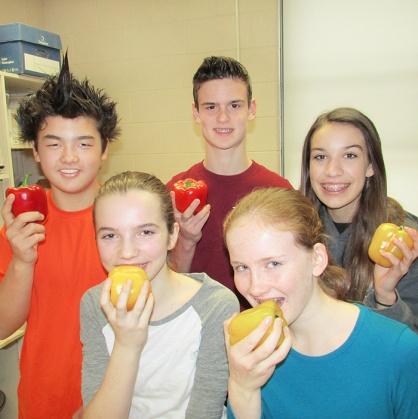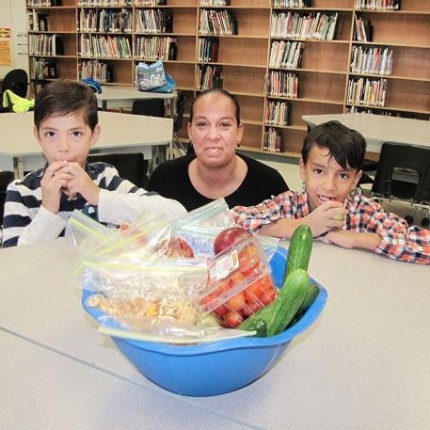Now this is a story all about how Chatham-Kent brought in Farm-to-School
Posted: May 18, 2016
Categories: Edible Education Network / Edible Education Project Profiles / Food in the News / GoodFoodBites / News from Sustain Members / Schools
 The following story presents OSNPN-SWR’s Farm to School pilot project and includes how the project works, evaluation data, lessons learned, and next steps.
The following story presents OSNPN-SWR’s Farm to School pilot project and includes how the project works, evaluation data, lessons learned, and next steps.
Written by Tiffany Gartner-Duff, Resource Development Coordinator, Ontario Student Nutrition Program – Southwest Region
Thanks for stopping by to hear about the Ontario Student Nutrition Program – Southwest Region (OSNP – SWR) Farm to School pilot project – now at 21 schools across Chatham-Kent, Ontario. OSNP- SWR in collaboration with Chatham-Kent Public Health Unit supports a fully funded delivery of produce for every participating student in the program, 5 days per week. This model develops more efficient strategies to assist schools in accessing local healthy food for their student nutrition programs. This benefits the students, local farmers and local economy! A win-win-win situation!
As I started writing this blog post (this is my first, by the way!), the words “Now this is a story all about how…” kept coming to mind. If anyone was a child growing up in the 90’s like I was, you probably know all the words to the catchy song from the hit TV show The Fresh Prince of Bel Air. Blog posts are supposed to be fun, right? So I thought why not start out telling Chatham-Kent’s Farm to School story Fresh Prince of Bel Air style. Here goes….
“Now, this is a story all about how
Chatham-Kent schools got flipped-turned upside down
And I’d like to take a minute
Just sit right there
I’ll tell all about you how we got kids to eat local produce here
In Chatham-Kent fruit and veggies are planted and raised
On the playground is where kids spend most of their days
Chilling out, maxing, relaxing all cool
And not eating a whole lot of produce grown around their school
When a health unit study showed kids ate no good
It was time something be done in the neighbourhoods
OSNP heard the news and got all scared
And said, we are movin’ forward with local fresh food over there
We whistled for some help and when it came near
Local farmers said yes and a group came to share
If anything I could say this was partnership was rare
But I thought, this is awesome, everyone really seems to care
Delivery trucks pulled up to the schools around 7 or 8
And yelled to the students “Yo kids, food’s here!”
We looked at our project
It was finally here
An amazing success that we’d like to share”
You rapped those lyrics, didn’t you? It’s hard not to! All fun and singing aside, we would like to share our success with how Farm to School came to be in Chatham-Kent. First off, you may be wondering where Chatham-Kent is. It is located in southwestern Ontario situated between Lake St. Clair on the east, and Lake Erie on the west. According to the 2011 census from Statistics Canada, there are 103,671 people currently residing in the Municipality of Chatham-Kent, which is comprised of a couple small cities and many towns. Agriculture is a significant part of life in Chatham-Kent and produces approximately 20% of all vegetables grown in Ontario. In fact this area is the #1 producer of tomatoes, corn and sugar beets (who knew?) and has a total of 2,000 farms ,which grow fruits and vegetables, eggs, meat, and dairy. That’s great, right? Well, kinda. In fact, a conundrum exists: “Our people in Chatham-Kent are low in their consumption of fruit and vegetables. According to a health unit survey, we are the lowest in Ontario. This pilot is aimed at increasing that consumption” stated Elaine Lewis, OSNP Chatham-Kent Coordinator.
This is the 3rd consecutive year we have offered the Farm to School program which will now enable 4,909 students to enjoy local fruits and vegetables every day for 16 weeks.
This year’s partners are 10 farms (7/10 are local farms), Southwestern Ontario Gleaners and Evans Wholesale. Grant money pays for the purchase of the fruit and vegetables from farmers at a fair market price. The schools do not have to pay for the delivery of fruits and vegetables each week. Menu choices include local products such as: apples, peppers, carrots, mini cucumbers, cherry tomatoes, strawberries, and dehydrated apple chips.
So how does Farm to School happen?
- Local farmers were invited to participate. Those that can fulfill the volume requests and seasonality requirements participate in the program.
- OSNP-SWR creates a set menu for schools and lets them know the schedule
- Evans Wholesale gathers the produce from the local farmers and sorts and delivers direct to the doors of schools once per week.
- Volunteers wash and prep the produce.
- Children enjoy the local fruit & vegetables!
The program has been very well received. Sarah Woodruff, professor at University of Windsor conducted an evaluation of the program. Here is some interesting feedback about the Farm to School program:
- According to the teachers, most fruit and vegetables were very well received by the students. One teacher suggested, “the Farm to School Program is the highlight of the day [for the students]!”
- Most teachers agreed that the delivery of the fruit and vegetables was seamless and did not take away from curriculum time. However, each school had it’s own delivery system. For example, in one school, the older students prepped the bins and delivered to the classroom, whereas in another school, the produce is located in a centralized location and the students know where to go and get it.
- Strawberries, grapes, and watermelon were clearly the favourites, and the dehydrated foods (squash, apples) were the least liked by the students. Younger students are pickier about the produce, whereas, the older students will finish off whatever is leftover at the end of the day. Students are pickier in the earlier phase of the program, yet by the end of the year, most are at least trying the produce, if not liking the produce. Approximately, 70% – 100% of elementary students tried at least one bite of all the fruit and vegetables offered;
 and ~25% of the secondary students regularly consume.
and ~25% of the secondary students regularly consume. - Several teachers mentioned that the Farm to School Program is very important at their school. It was suggested that beyond the nutritional aspect of this program, teachers are able to highlight manners, food handling/safety (hand sanitizer, using tongs), negotiation skills (only taking what you plan on eating), math skills (or other subjects), and language skills (learn the name of the fruit & vegetable in both English and French).
- Teachers agreed that they thought the students were reliant on the program (or looked forward to it) and many come to ask what’s being served each day.
- “We found they will eat more when they’re with their peers than they will at home,” said Elaine Lewis of the students’ response. “And they are going home and asking the parents for some of these products they’re getting at school.” And they aren’t just grazing, but rather last year in the program, students were eating an estimated 4,000 lbs. of apples, peppers, grape tomatoes and other locally grown healthy options.
- The local farmers benefit and students create healthy eating habits. “Farm to School programs supports better relationships between local farmers and youth. This relationship encourages life-long healthy eating habits and supports local economies,” says Jillian McCallum, Food and Logistics Coordinator for the Ontario Student Nutrition Program.
What we learned
- Some produce products can be challenging for once a week deliveries to schools. Last year deliveries occurred on Mondays and orders included a shelf stable product (dehydrated apple chips for example) that was served on the Monday of the following week.
- Sometimes the bananas were bruised and the carrots were white/dry yet other times were slimy wet, so not always the best uptake. We had to develop a quick feedback loop process in which schools could inform us about their issue and it be resolved quickly with a new produce item (and to learn why it happened so it wouldn’t happen again).
- Teachers also mentioned that sometimes too much non-reusable products were used (e.g., Ziplocs, brown bags, etc.). We are working on more ‘green’ strategies to reduce waste in the program.
- Some of the feedback from schools was that “students at this school don’t need the program”. We need to better communicate the numerous benefits of the program for all children regardless of socio-economic status.
- Parents were unaware of the program offering local food to their children. We need better communication strategies to help spread the word about the local advantages for students, farmers and the local economy!
What’s up next?
In conjunction with teachers college students at the University of Windsor, we are working on Farmer Profiles a Food Miles Map which shows how far food travels to get to the mouths of students in southwestern Ontario. This idea came directly from feedback from Farm to School teachers said they would like a map of farmer location (so they could use the info in math class, history, and/or environment class). This would also help promote the local community farmers who are involved in the program.
We hope to continue to expand Farm to School to offer the program to more schools in the coming years. It’s been a wonderful learning experience in which local students and the local economy has benefitted.
Thanks for reading all about OSNP-SWR’s Farm to School project in Chatham-Kent. Let us know if you have any questions! Lastly, sorry to anyone who has The Fresh Prince of Bel Air song stuck running through their heads!
By: Tiffany Gartner-Duff
For more information about the project contact:
Jillian McCallum
Food and Logistics Coordinator
Ontario Student Nutrition Program – Southwest Region
519-254-4866 Ext. 6260
